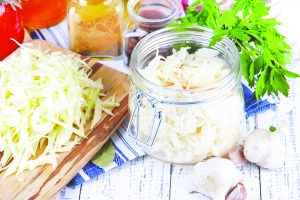Probiotics — a guide to a healthier gut
By Angela Shelf Medearis — March 6, 2020When it comes to making healthy eating choices, there is a constant barrage of information. Fueled by a multi-billion-dollar industry, marketers try to convince us that their products are just what we need to feel good and be healthy. When it comes to probiotics, for example, what do consumers need to know to make an informed buying decision?
Probiotics are the “friendly” bacteria that reportedly help improve or maintain good gut health. Probiotics contribute to a healthy gut flora. These live microorganisms can help you have good digestion, boost your immune system and even provide you some important vitamins. Many foods are now enriched with probiotics, which also can be purchased in supplement form.
“Non-harmful” bacteria are formed during the fermentation process. But if processing (usually through heating or cooking) destroys these bacteria and they are no longer live, they also may no longer be beneficial.
According to Dr. Joel B. Mason, a professor at Tufts University, “There are over 100 different types of organisms that might be called ‘probiotics,’ and each one is very different.”
Research has shown that certain strains help in specific situations. For example, for older hospitalized patients who might otherwise have diarrhea caused by broad-spectrum antibiotic therapy, certain probiotics help promote good digestion by fighting off bad bacteria in the gut, just as naturally occurring good bacteria do.
But research does not yet substantially support some benefits touted by marketers of probiotic foods and supplements. These include claims that probiotics improve the immune system, reduce symptoms of the flu or colds, or prevent constipation.
For thousands of years, cultures around the world have consumed probiotics by eating fermented foods, which include all yogurts, aged cheeses, cottage cheese, pickles (brine cured without vinegar), tempeh, tofu, kimchee, miso, microbrewed beers and wine, and sauerkraut.
Sauerkraut has ancient origins dating back more than 2,000 years. Legend tells us that fermented cabbage was a food staple for workers constructing the Great Wall of China. In the summer, laborers building the wall lived on cabbage and rice. In the winter, the cabbage was preserved with rice wine, which soured the cabbage, keeping thousands of workers healthy in the worst of conditions.
Probiotics found at the store usually contain only one strain of bacteria or a few strains that are thought to be helpful. On the other hand, raw sauerkraut can contain a mixture of over 13 different species of gut-friendly bacteria.
Each batch of sauerkraut you eat may contain different proportions of different strains of probiotics. Including a variety of strains can help you diversify and improve your gut flora.
Raw sauerkraut can not only be a healthy way to supplement your diet with gut-friendly bacteria, but it also can add an exciting new flavor to your meals. Sauerkraut contains various strains of probiotics, vitamins B and C, beneficial enzymes, Omega-3 fatty acids and lactic acid that fights off harmful bacteria.
To keep the probiotics it contains alive, do not heat or cook sauerkraut. Add raw sauerkraut to salad, as a garnish to meat or as a side dish to accompany a breakfast of eggs and sausages. This recipe for Spicy Sausage and Sauerkraut Sandwiches uses raw sauerkraut as a topping, like adding pickles to a burger, but with more health benefits. It’s a delicious way to improve your gut health!
SPICY SAUSAGE AND SAUERKRAUT SANDWICHES
1 pound bulk spicy pork sausage
2 medium green and/or sweet yellow peppers, ribs and seeds removed, chopped
1 medium onion, chopped
8 pretzel or regular hamburger buns, split
8 slices pepper jack or provolone cheese
1 1/2 cups sauerkraut, rinsed and well-drained
2 tablespoons Dijon mustard, optional
- Heat oven to 350 F. In a large skillet, cook sausage over medium heat 4-6 minutes or until no longer pink, breaking into crumbles; drain.
- Add bell peppers and onion; cook and stir 8-10 minutes longer or until vegetables are tender.
- Place bottom burger buns on a foil-lined baking sheet. Spoon meat mixture onto bun; place cheese over meat. Bake 4-6 minutes or until cheese is melted.
- Remove from oven and top with the sauerkraut. Add Dijon mustard, if desired. Put top buns on the sauerkraut and meat mixture and serve immediately. Serves 8.
***
Angela Shelf Medearis is an award-winning children’s author, culinary historian and the author of seven cookbooks. Her new cookbook is “The Kitchen Diva’s Diabetic Cookbook.” Her website is www.divapro.com. To see how-to videos, recipes and much, much more, Like Angela Shelf Medearis, The Kitchen Diva! on Facebook. Recipes may not be reprinted without permission from Angela Shelf Medearis.
© 2020 King Features Synd., Inc., and Angela Shelf Medearis








